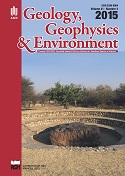Lithological variations of sedimentary succession within a meteorite impact crater: Jwaneng S Structure, Botswana
Main Article Content
Keywords
meteorite, impact, Kalahari, Jwaneng, sedimentary infill
Abstract
The Jwaneng South Structure is a meteorite impact crater located in the Kalahari region of Botswana. The structure has the shape of a bowl 1.3 km in diameter and a maximum depth of 275 m in the centre. It was discovered by an airship-mounted full tensor gravity gradiometer and penetrated by nine vertical diamond drill-holes. The crater is underlain by the Gaborone Granite (2785 Ma) and basalts of the Karoo Supergroup (182 Ma). The covering aeolian sediments of the Kalahari Group (Late Cretaceous-Recent) completely obscure the structure.
A succession of the following lithofacies overlying authigenic in situ brecciated granite was intersected in the boreholes (from base to top): (i) allogenic heterolithic/oligomictic “fallback” and resedimented breccia (ii) sedimentary breccia and conglomerate with sand matrix; (iii) six intervals of carbonate sediments, with traces of evaporites and mudstone interbeds, which are interlayered with (iv) five intervals of sandstone and sedimentary breccia composed of granules, pebbles and cobbles, mostly of granite, embedded in a matrix of well-sorted medium-grained sand; (v) bioturbated, mostly massive sandstone rich in mud matrix (wacke), with locally preserved interbeds of mudstone and cross-bedded sandstone, and abundant root traces; (v) silcrete and calcrete that occur at the top of the succession.
This lithological association suggests that deposition within the Jwaneng South meteorite impact crater took place in a playa lake surrounded by steeply-dipping talus piedmont fans. The depositional cycles were controlled by pronounced climatic oscillations. Wet periods are recorded by lithofacies (iii), which reflects intense supply of sand eroded from the Kalahari dune field surrounding the crater and coarse detritus derived from its rim and steep talus below. Dry intervals of high evaporation and fall of the lake level are reflected by lithofacies (iv). During the youngest wet period (v) the lake filled up with alluvia sands interbedded with muds, abundantly vegetated and homogenised by bioturbation. The silcrete and calcrete layer at the top of the succession is the product of pedogenic processes that affected the Kalahari Desert environment. An asymmetry of lateral distribution of the lithofacies (ii) – (iv) and the presence of sedimentary breccia redeposited into the marginal E (and NE) parts of the crater suggest an asymmetry of the crater depression and its coarse clastic rim, which may imply an oblique trajectory of the impactor approaching from the SW.Downloads
References
Carney J., Aldiss D. & Lock N., 1994. The Geology of Botswana. Bulletin, 37, Geological Survey of Botswana, Lobatse.
Dence M.R. & Guy-Bray J.V., 1972. The Brent Crater. [in:] Some Astroblemes, Craters, and Cryptovolcanic Structures in Ontario and Quebec. International Geological Congress, Twenty-Fourth Session, Canada 1972, Field Excursion, 11–18.
Du Plessis P.I. & Le Roux J.P., 1995. Late Cretaceous alkaline saline lake complexes of the Kalahari Group in northern Botswana. Journal of African Earth Sciences, 20(1), 7–15.
Haddon I.G. & McCarthy T.S., 2005. The Mesozoic–Cenozoic interior sag basins of Central Africa: The Late-Cretaceous–Cenozoic Kalahari and Okavango basins. Journal of African Earth Sciences, 43, 316–333.
Hatch D., 2004. Evaluation of a full tensor gravity gradiometer for kimberlite exploration. [in:] Lane R.J.L. (ed.), Airborne Gravity 2004 –Abstracts from the ASEG-PESA Airborne Gravity 2004 Workshop, Geoscience Australia Record, 2004/18, 173–180.
Key RM & Ayres N. 2000 The 1998 edition of the National Geological map of Botswana. Journal of African Earth Sciences, 30(3), 427–451 with CD.
Master S., 2010. Fractured basalt and mafic breccia dikes from the buried 1.3-km diameter Jwaneng South Structure, Botswana. [in:] Abstract, Session P05: Impact Cratering on Solid Planets – Shocks on Basalt. American Geophysical Union, ‘The Meeting of the Americas’, 8–13 August 2010, Foz do Iguaçu, Brazil, P43A–08.
Master S., Wendorff M. & Pitts B., 2008. Jwaneng South Structure, Botswana: a new 1.2 km diameter buried Cenozoic impact crater. [in:] 33rd International Geological Congress, Oslo, 4-14 August 2008, Thematic Session: PIS-01: General contributions to impact structures. Abstracts on CD-ROM.
Master S., Pitts B. & Wendorff M., 2009. Jwaneng South Structure, Botswana: a new 1.3 km diameter buried Cenozoic impact crater discovered by airship-mounted gravity gradiometer. [in:] Vogt D. & Fourie C.J.S. (eds), 11th SAGA Biennial Technical Meeting and Exhibition Swaziland, 16–18 September 2009, 97–100.
McFarlane M.J. & Eckardt F.D., 2006. The ‘Transparent’ Linear Dunes of Northwest Ngamiland, Botswana. Botswana Notes & Records, 36, 136–139.
Nash D.J. & McLaren S.J., 2003. Kalahari valley calcretes: their nature, origins and environmental significance. Quaternary International, 111, 3–22.
Nemec W., Steel R., Gjelberg J., Collinson J.D., Prestholm E., Oxnevald I.E. & Worsely D., 1988. Exhumed rotational slides and scar infill features in a Cretaceous delta front, eastern Spitsbergen. Polar Research, 6, 105–112.
Partridge T.C. (ed.), 1999. Tswaing: Investigations into the Origin, Age, and Palaeoenvironments of the Pretoria Saltpan. Council for Geoscience: Memoir, 85, Council for Geoscience, South Africa.
Thomas D.G.S. & Shaw P.L., 1991. The Kalahari Environment. Cambridge Uiversity Press, Cambridge.
Ward J.D., 1987. The Cenozoic succession in the Kuiseb Valley, Central Namib Desert. Geological Survey Namibia: Memoir, 9, Geological Survey, Department of Economic Affairs.
Wendorff M. & Master S., 2015. Cyclic lacustrine sedimentation in a meteorite impact crater: the Jwaneng South Structure in the Kalahari, Botswana (SW Africa). [in:] 31 st IAS Meeting of Sedimentology, Kraków 22 June 2015: abstracts, Polish Geological Society, Kraków.


